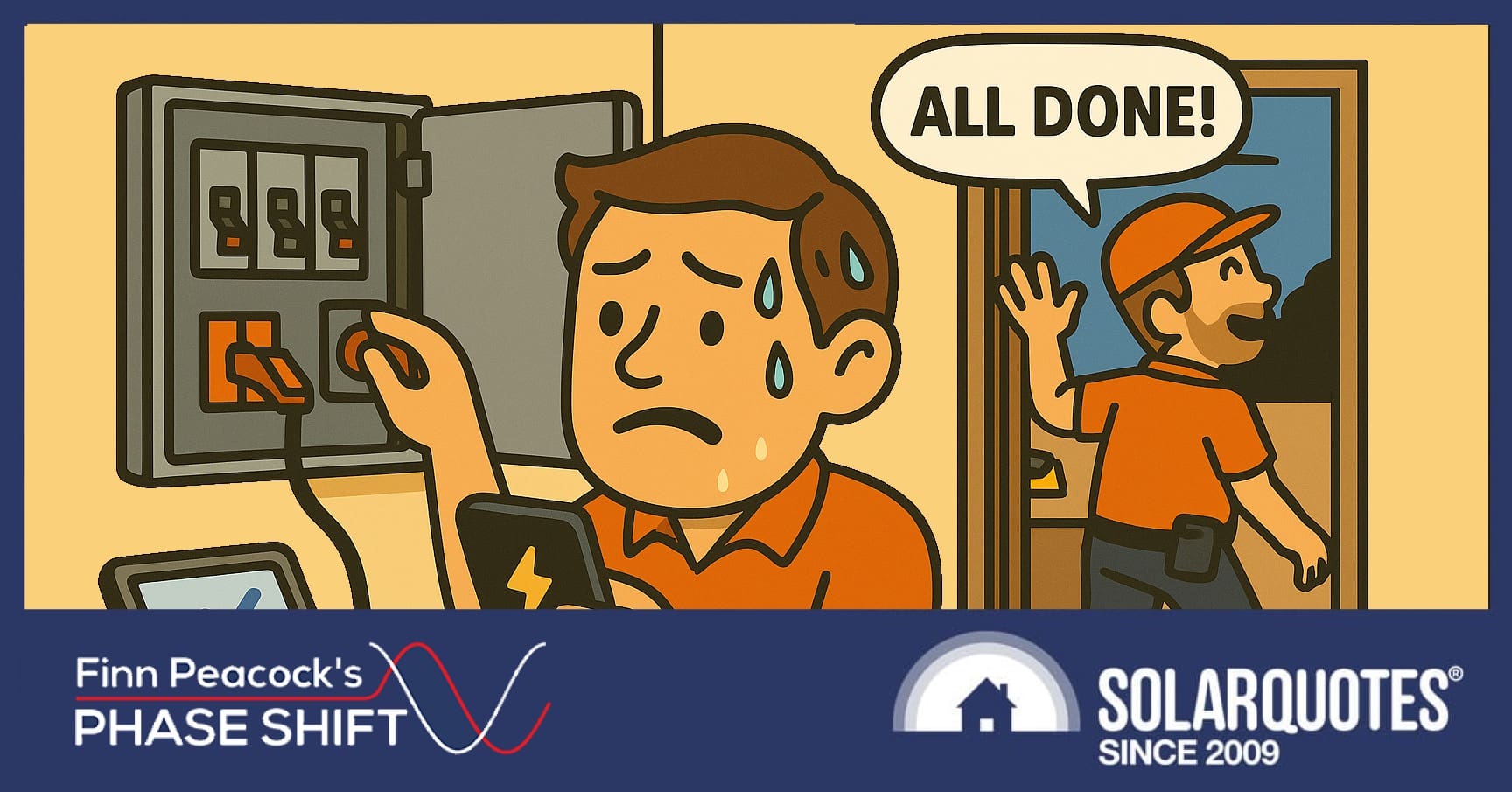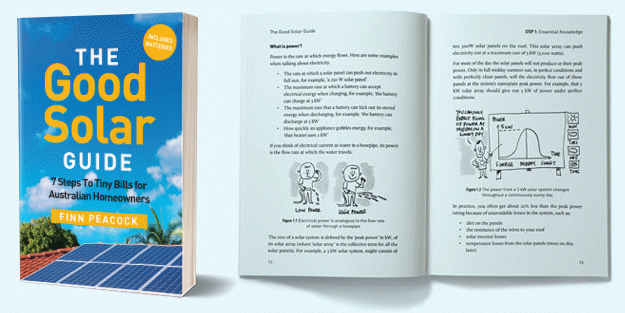Back in my engineering days, I designed control systems for everything from nuclear power plants to optical semiconductor fabs. High-stakes stuff, where things not working properly was frowned upon. One thing that became clear early on: the hardware install was just the beginning. The real work started when you powered things up and tried to make them behave.
Which brings me to today’s Phase Shift.
Battery installs have gone ballistic since the rebate landed, and most of the systems we’re seeing look great. Neat cabling. Solid labelling. Even cable tray! But more and more, I’m hearing stories of new battery owners being left with a system that works, but hasn’t been configured properly.
That’s a problem.
Case in point: tech journo Adam Turner.
Adam recently wrote about his Sigenergy battery install in GadgetGuy. It was a solid install except nobody configured the Dynamic Load Management (DLM).
So when Adam fired up the EV charger (7kW) and then the battery started charging full tilt (10kW), he tripped the grid supply. Adam had to call the installer, and seemingly tinker with the Sigenergy app himself to find a safe grid import limit in the battery’s DLM feature that wouldn’t trip his 63A main fuse again.
Let me be clear: this shouldn’t have been Adam’s job.
Adam’s setup: 32A car charger + 43A battery charger on a single-phase connection – needs load management. Otherwise, it’s just a question of when you trip out, not if.
Every battery and EV charger installer must understand this. Commissioning a battery system is not just connecting wires and checking that the monitoring app shows nice numbers. It is configuring a control system for the home.
Right now, it’s common to hear from battery owners left on their own to figure this out, or worse, ask strangers in a Facebook group how to set the backend parameters for their home battery system. That’s nuts.
Homeowners Aren’t Control Engineers
We’re in a honeymoon period where most people buying batteries are earlyish adopters. Some are uber-nerds like Adam, who don’t mind spending a week fine-tuning their setup.
But that won’t last. And honestly, it shouldn’t be expected of anyone – nerd or not. A regular homeowner shouldn’t have to ask a Facebook group why their house keeps losing its grid connection.
Installers Need to Build in Configuration Time
Homeowners: if your installer hasn’t walked you through the system or appeared to do any of the steps listed below, then ask that they do so to save you some huge headaches later.
Retailers/Installers: if you’re not already adding at least a couple of hours for system setup, testing, and education in your quotes, start now.
That time should be used to:
- Walk through the system and the app with the owner
- Check tariffs, backup priorities, charge/discharge schedules
- Test edge cases (like car + battery + ducted AC all on at once)
- Set dynamic limits based on the site’s electrical constraints
- Configure EV charger/battery interaction
- Check 3-phase self-consumption is configured correctly (a biggie with Sigenergy)
- Set a follow-up appointment in a couple of weeks, where you review the operation so far and make any tweaks as required.
And yes, it should be added as a line item on the quote. It’s valuable work. Installers are not selling a battery. They’re delivering a finely tuned control system that manages energy flow across the whole home. And if an installer leaves without commissioning it properly, they’re not done.
Phase Shift is a weekly opinion column by SolarQuotes founder Finn Peacock. Subscribe to SolarQuotes’ free newsletter to get it emailed to your inbox each week along with our other home electrification coverage.


 RSS - Posts
RSS - Posts



This is a modern day problem – not confined to solar systems. Case in point, we recently had our internet phone’s ATA fail. Getting a replacement from the service provider proved impossible. Every person I spoke to after being on hold for hours promised to send one – never happened. In the end I purchased a “functional” replacement as the fialed unit was no longer been made. It would not play nice with the IP service and again after many hours of dealing with support people with zero technical knowledge, I gave up and hunted down a direct NOS replacement, made in the USA. However, it was still up to me to program all the settings. Luckily I had enough experience with IT comms to figure it out. As you say, this sort of set-up programming should not be left to the consumer, but increasingly, support people are not trained to a sufficient level beyond the standard, “Have you tried rebooting the unit ?”
The poor level of tech support in general is beyond belief !
“This is a modern day problem”
Indeed, and it can only get worse. My big concern is how almost every device now needs a mobile phone app to configure it. Will companies keep these apps up to date with the fast-changing phone technologies? And will they keep backward compatibility with older models? I can see people having to buy a new phone every few years just so they can keep using their solar panels, batteries, cars, toasters, etc.
It’s not surprising that tech support is getting so bad. They can’t possibly keep up with every possible variation out there.
You need to make sure you educate your referred installers/companies of the need to explain the operation and set up of the app, mine did not explain it to me, he just did it when I was out of sight. Then when I queried it, he said ask Zeco about it they know more than me. They seem to have the attitude that they are electricians and not system educators.
We had a Powerwall battery installed a couple of weeks ago. Last week a technician from Techsafe inspected the installation and noted several relatively minor issues. Techsafe are carrying out these inspections for the Clean Energy Regulator (CER) at no charge to homeowners.
Neither the technician or the installer raised the issue of DLM and EV charging. In any case, I have set our Wallbox EV charger to a limited charge rate as we rarely need to charge for more than a couple of hours off-peak.
Yeah, i have noticed quite a few people asking for this sort of help in facebook groups, bit of a worry.
Very good advice Finn. The exact same thing happened to me after my recent install (and from one of your recommended installers). I worked out how to set an import limit myself despite asking for it to be done during the install.
That’s a very interesting point.
When I had my system installed several years ago,they did everything.
I have 3 phase with whole of house backup.
I am only able to draw 3.3 kW from each phase in backup mode, so we went through each phase to make sure we wouldn’t overload anything and trip the inverter.
It meant we had to rewire the resistive HWS onto it’s own phase and swap the element from 3.6 to 2.4 kW.
We did some changes in the kitchen circuits too.
The final step was installing a “power on delay” for the pump that supplies water to the house, because it would immediately start at power up and the startup inrush would overload one of the phases.
We also tested everything and that made me feel very comfortable.
I think one big issue is that many customers are price driven without understanding the back end things that can go wrong or things that need to be tested thoroughly.
It’s only after the installation and circumstances, that they find out what doesn’t work.
I was really impressed with my installation of battery last year, and addition of more modules this year.. however your article highlights a huge problem.
I consider myself pretty tech savvy, I write some code, manage database, and some IT gear, etc etc.. but really, when handed a system and almost zero ‘hand over’ one on one, I was out of my depth. The Sungrow app is anything but intuitive, and some of the weird requirements of its settings made it very easy to either mess up, or not implement the desired settings).
The problem I see is that in the rush to deliver a quote that can compete, the cost of having someone sit down and spend time explaining a multitude of different system’s apps to home owners who are often, and I am being nice, IT illiterate.. is prohibitive. The company that does not offer that as part of install practice will always be able to undercut the others.
Great info Finn, and taken on board for when we take the battery leap.
I do consider a basic walk through should be standard practice for regular solar installs and their apps too, and that can be greatly ignored as well.
My installer didn’t bother to run though any thing, he was half way out the door when I caught him leaving. He also didn’t connect the battery to the house correctly so no I have chase the guy up.
And no the company wasn’t the cheapest I went with, had good reviews been in business for 5 years but what they dint tell me is that they are the project managers and don’t install it them selves
It is not just configuration. Accessing a wide range of features and learning how to make best use of them should not be left to the system owner with no installer assistance other than “there are lots of videos online’s”.
Our installer didn’t just demonstrate his lack of ability to install the system he simply did not understand how aspects of back up and the battery functioned.
I have ended up watching many of the videos produced by Fronius targeting installers and technicians to learn how to make best use of the programmable features of a Gen24 Plus with BYD battery.
My solar installer made me commission my equipment, set it up connect it to the internet
Upgrade the firmware
He installed it and left and never came back
And then got me to call the manufacturer when he couldn’t remote access it because he never set it up
The manufacturer could see the system and he couldn’t
Turned out he needed to make his own profile which he didn’t because he never did anything
So interesting stuff I eventually found the setting and put in his email address
We paid alot for a 22kw solar system and battery but he just could not be bothered.
Don’t know if he can access the solar system.
Recently I found out how to force change the batteries if you have an impending weather event
This would have been useful during a cyclone
Which we had
Good times
As I have mentioned in another discussion, the Tesla (Powerwall) app now allows user to “schedule” a top-up event. Basically The battery starts charging from the grid for a user-specified number of hours. This “advanced” feature is only available if a smartphone is paired to the Powerwall.
I have used it on a couple of heavily overcast days to top up the battery ready for the evening peak.
A very good blog post Finn. Long overdue.
My wife and I recently had the same experience as some of the other good people commenting on here regarding a great installation but then left on our own to work out the configuration of the software.
We recently had Solar PV + battery installed. It took me a couple of weeks trying to work out how to set it up for our needs using online forums and videos and just trial and error to obtain the dial in needed for us. It shouldn’t be so. Your last message (last paragraph) is so true.
The issue is two-fold:
98% of consumers only care about the price. They know the price of everything and the value of nothing. You can’t blame installers for leaving out this line item in the quote because I reckon the majority of the public don’t appreciate the importance of this service.
98% of installers are tradespeople used to installing hardware and move on to the next job. They are unlikely to understand the relevance or importance of your last paragraph.
Spot on. It’s only going to get worse. In my experience, it’s rare to find people in any domain who understand a system versus components. For anything important, such as our off grid energy system, I configure, enhance and support it myself. Thankfully, there’s a very healthy Victron DIY community on-line and Victron employees actively participate.
Most don’t have the background, time or inclination to become experts in this stuff.
Every battery installer so far has not mentioned anything other than basic setup.
I am from the IT side so I dont understand what is so hard. Working for the SEC left me very aware of poor adaptability of modern solar control systems.
I dont mind paying to change inverters to suit the new designs but “installers” dont want the hassle of setup on a new battery properly.
2 strings into a simple AC inverter. I have no intention of ever being part of a VPP so its a hold off until i can get some decent controls.
the farm had a big 200 amp isolation mechanical switch on the wall you rotated into place by hand,,, solar or generator
dynamic limitations (no ev’s here) , priority battery charging, peak hour export limitations all seem to cause installer’s eyes to glaze over when discussing the job.
>>may have to go find a nice antique 200 amp rotary mains switch.
From Carl Sagan’s Demon-haunted World published in 1996:
“We’ve arranged a global civilization in which most crucial elements—transportation, communications, and all other industries; agriculture, medicine, education, entertainment, protecting the environment; and even the key democratic institution of voting—profoundly depend on science and technology. We have also arranged things so that almost no one understands science and technology. This is a prescription for disaster.”
30 years later it seems that things are actually getting worse!
I’ve had issues the Sig Energy install. Not enough time explaining the system and not a great response when contacting the installer to address problems. It seems installers are more worried about installing new systems than addressing concerns from existing customers. Key issues are:
1. App doesn’t measure actual usage. When an air conditioner is running it reads 0 load.
2. 20% to 50% of the solar generated goes into the grid when the battery is not full despite the sequence being set to house load first, battery second and grid third. This means I am losing approx. $950 per year in savings.
3. Turn on a 2.1 kW EV car charger and the Sig app reads 6-8kW.
System is working but the payback will be about 20 years given the inefficiencies.
I have the same issue with my system and my installer the user form think it might be this
CT = current transformer. It measures the amps going through each circuit. If you dont have one or more likely it is the wrong way round, it will not show anything for that circuit which is pretty much what you have.
Thanks for that. I’ll follow up with the installer.😀
I suspect the biggest problem is not that installers won’t take a customer through the setup but rather that many installers themselves struggle with the setup parameters. On top of that it is often individual to the particular situation. Is the consumer going to connect to a VPP? Amber? or a Super off peak rate? All these scenarios might require different parameters to achieve the most cost effective outcome. Excellent articles like this are unlikely to be read by the consumer who really needs help because most here are sophisticated users who can probably figure things out for themselves.
It’s actually positive that people are hopping on to FB and figuring things out for themselves. There is value in community help – if you own a car and there’s an issue, there’s a FB group or owner’s forum for that. Shouldn’t be necessary but better than nothing.
I have my battery installed 2021. I find now that I have no instructions. I assumed that we would automatically switched to the grid when the battery was empty (limit was set). To my surprise the power suddenly fell out when we had aircons blasting to get some heat into a very cold Ipswich morning. We had no idea what was happening! The installer could not view our monitoring system as…when I got a new router from Optus the solar monitoring does not work anymore. The installer tried to get it connected but could not figure it out. However, he offered no solution (like do I buy a new router?). I also wanted to him to check what I’ve written down for future events? This will ensure I don’t need to bother him. I can’t get him to respond to something so
I actually want another module but still no response. I don’t know what to do!
If you change your router, the simplest solution is to use the same name and password that the old router had, then all your systems (not just your solar) should work just fine.